22–24 High Street, Sheerness, Kent, ME12 1NL
The Belle and Lion was first public house to be built in Mile Town. Other inns and ale houses were built soon after. The Belle and Lion is listed in a local directory of 1824 and a more recent one published in 1938. Boots store now stands on the site of the inn, at 59 High Street.
A plaque documenting the history of The Belle and Lion.
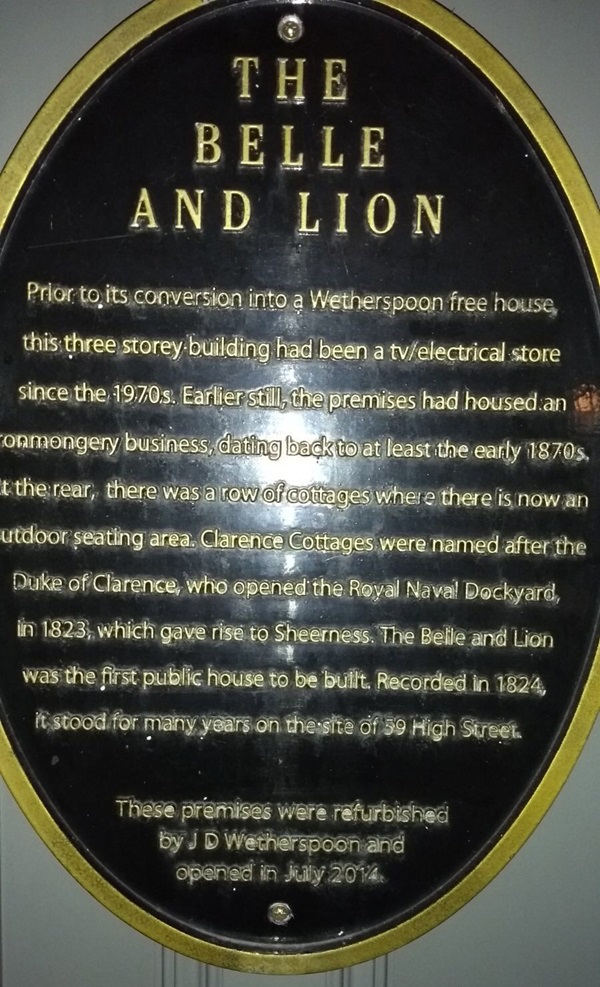
The plaque reads: Prior to its conversion into a Wetherspoon free house, this three storey building had been a TV/electrical store since the 1970s. Earlier still, the premises had housed an ironmongery business, dating back to at least the early 1870s. At the rear, there was a row of cottages where there is now an outdoor seating area. Clarence Cottages were named after the Duke of Clarence who opened the Royal Naval Dockyard, in 1823, which gave rise to Sheerness. The Belle and Lion was the first public house to be built. Recorded in 1824, it stood for many years on the site of 59 High Street.
These premises were refurbished by J D Wetherspoon and opened in July 2014.
Photographs and text about James Thomas Byford McCudden.
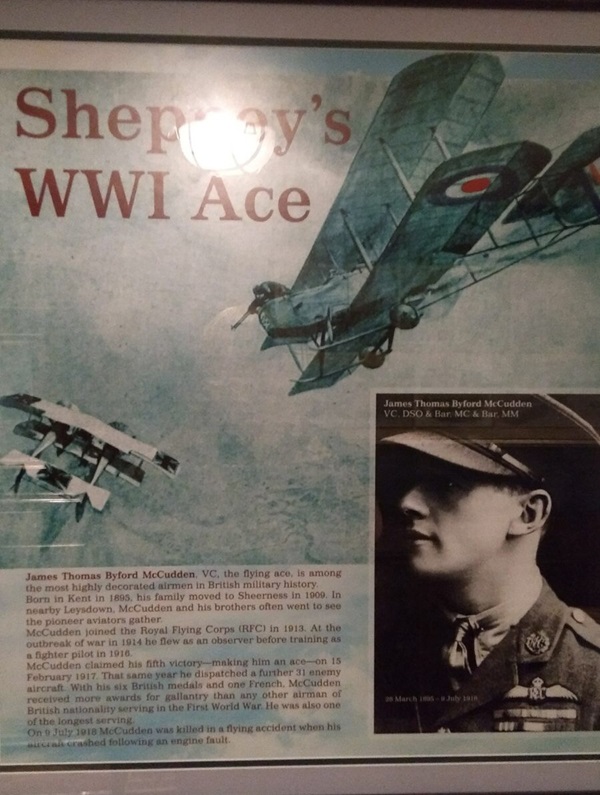
The text reads: James Thomas Byford McCudden, VC, the flying ace, is among the most highly decorated airman in British military history. Born in Kent in 1895, his family moved to Sheerness in 1909. In nearby Leysdown, McCudden and his brothers often went to see the pioneer aviators gather.
McCudden joined the Royal Flying Corps (RFC) in 1913. At the outbreak of war in 1914 he flew as an observer before training as a fighter pilot in 1916.
McCudden claimed his fifth victory – making him an ace – on 15 February 1917. That same year he dispatched a further 31 enemy aircraft. With his six British medals and one French, McCudden received more awards for gallantry than any other airman of British nationality serving in the First World War. He was also one of the longest serving.
On 9 July 1918 McCudden was killed in a flying accident when his aircraft crashed following an engine fault.
A print of some of the earliest pioneer aviators.
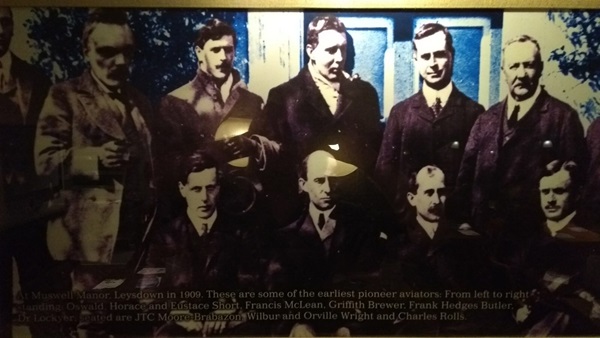
The text reads: At Muswell Manor, Leysdown in 1909. These are some of the earliest pioneer aviators. From left to right standing: Oswald Horace and Eustace Short, Francis McLean, Griffith Brewer, Frank Hedges Butler, Dr Lockyer; seated are JTC Moore-Brabazon, Wilbur and Orville Wright and Charles Rolls.
Prints of Sheerness from the sea and air.
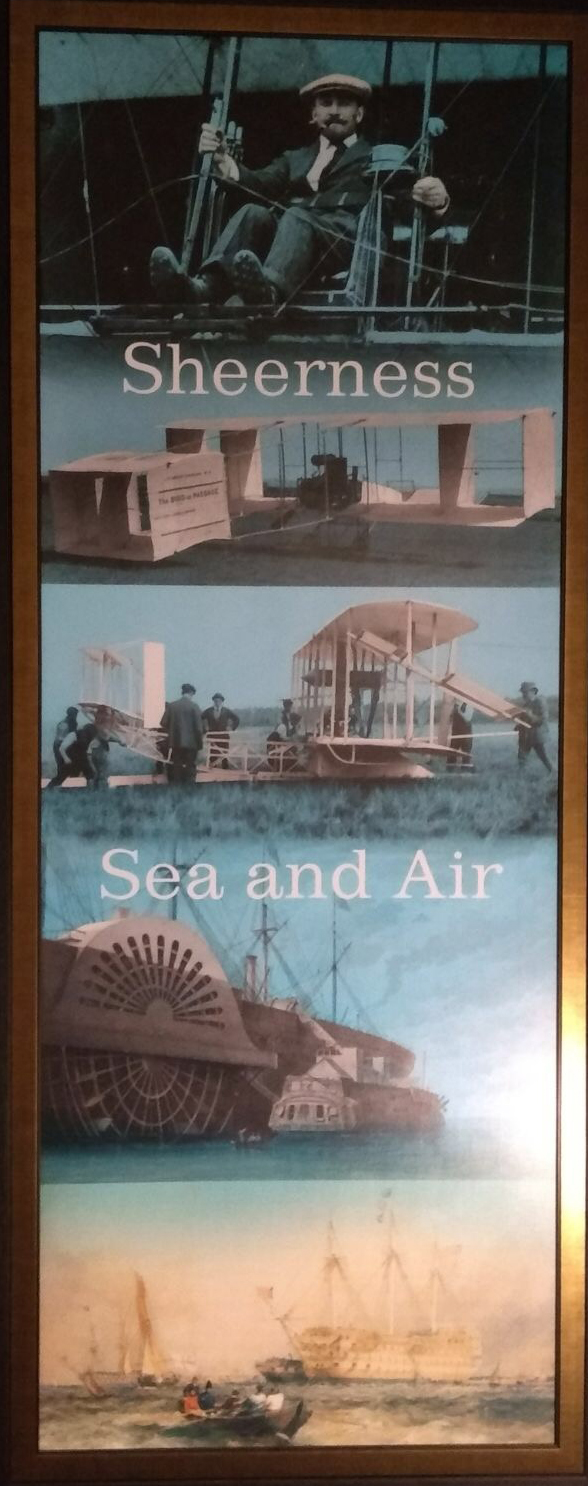
From bottom to top:
The Temeraire stationed off Sheerness, water colour by JMW Turner, 1834. From 1820 to 1838 the Temeraire was permanently moored here on harbour duties.
Laying the Atlantic cable, The Great Eastern was loaded with cable and set out from Sheerness in June 1866.
The second Wright biplane built by Short Brothers. Horace Short is on the right. The plane was launched tail first, catapult style, by being pulled at speed along a wooden track.
The Bird of Passage, the kite-like biplane in which JTC Brabazon made the first British flight in May 1909.
Charles Samson at the controls of his short biplane, ready to be launched from the sea into the air.
Illustrations of Sheerness.
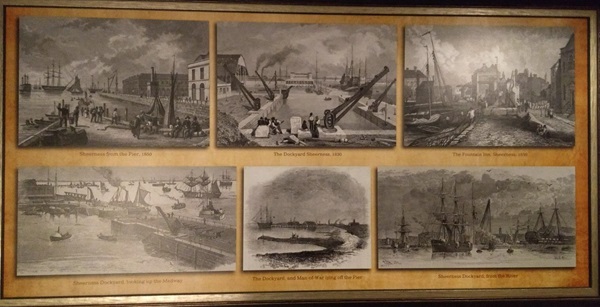
Above: left, Sheerness from the Pier, 1850.
Above: centre, The Dockyard, Sheerness, 1830.
Above: right, The Fountain Inn, Sheerness, 1850.
Below: left, Sheerness Dockyard looking up the Medway
Below: centre, The Dockyard, and Man-of-War lying off the Pier.
Below: right, Sheerness Dockyard from the River.
Prints, photographs and text about flying in the Isle of Sheppey.
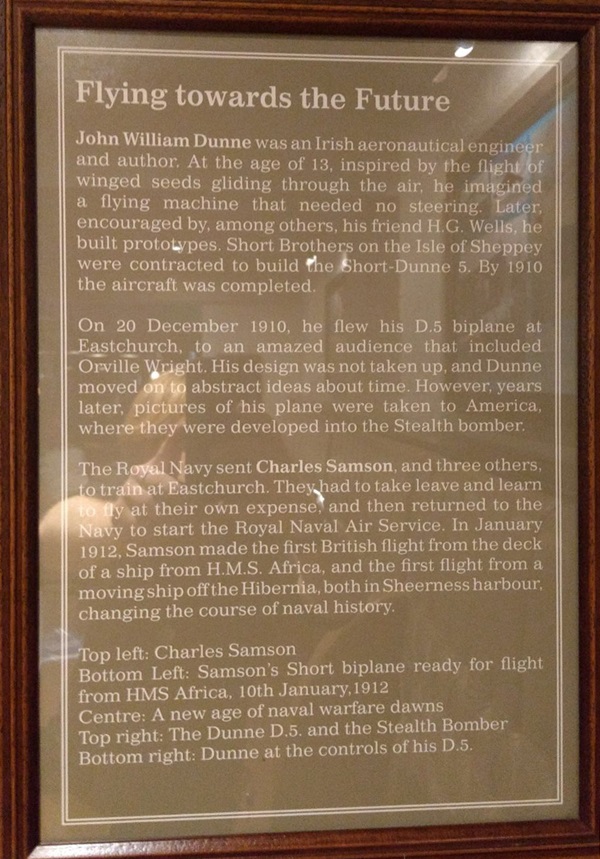
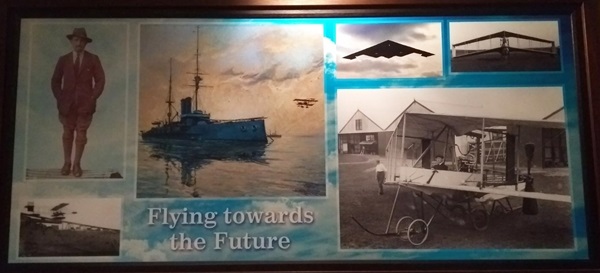
The text reads: John William Dunne was an Irish aeronautical engineer and author. At the age of 13, inspired by the flight of winged seeds gliding through the air, he imagined a flying machine that needed no steering. Later encouraged by, among others, his friend HG Wells, he built prototypes. Short Brothers on the Isle of Sheppey were contracted to build the Short-Dunne 5. By 1910 the aircraft was completed.
On 20 December 1910, he flew his D5 biplane at Eastchurch, to an amazed audience that included Orville Wright. His design was not taken up, and Dunne moved on to abstract ideas about time. However years later, pictures of his plane were taken to America where they were developed into the Stealth bomber.
The Royal Navy sent Charles Samson, and three others, to train at Eastchurch. They had to take leave and learn to fly at their own expense, and then returned to the Navy to start the Royal Naval Air Service. In January 1912, Samson made the first British flight from the deck of a ship from HMS Africa, and the first flight from a moving ship off the Hibernia, both in Sheerness harbour, changing the course of naval history.
Top left: Charles Samson
Bottom Left: Samson’s Short biplane ready for flight from HMS Africa, 10 January 1912
Centre: A new age of naval warfare dawns
Top right: The Dunne D5 and the Stealth Bomber
Bottom right: Dunne at the controls of his D.5.
Prints and text about Queenborough Castle.
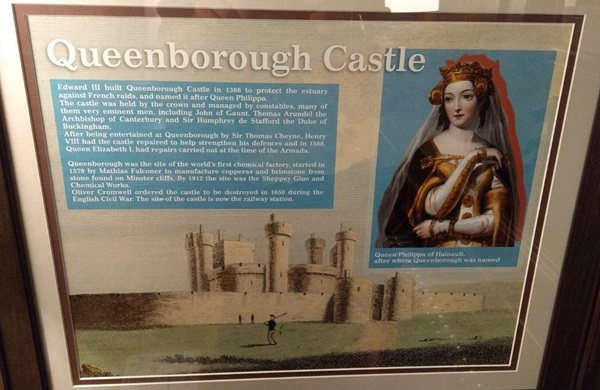
The text reads: Edward III built Queenborough Castle in 1366 to protect the estuary against French raids, and named it after Queen Philippa. The castle was held by the crown and managed by constables, many of them very eminent men, including John of Gaunt, Thomas Arundel the Archbishop of Canterbury and Sir Humphrey de Stafford the Duke of Buckingham. After being entertained at Queenborough by Sir Thomas Cheyne, Henry VIII had the castle repaired to help strengthen his defences and in 1588, Queen Elizabeth I had repairs carried out at the time of the Armada.
Queenborough was the site of the world’s first chemical factory, started in 1579 by Mathias Falconer to manufacture copperas and brimstone from stone found on Minster cliffs. By 1912 the site was the Sheppey Glue and Chemical Works.
Oliver Cromwell ordered the castle to be destroyed in 1650 during the English Civil War. The site of the castle is now the railway station.
Prints of historical figures associated with Queenborough Castle.
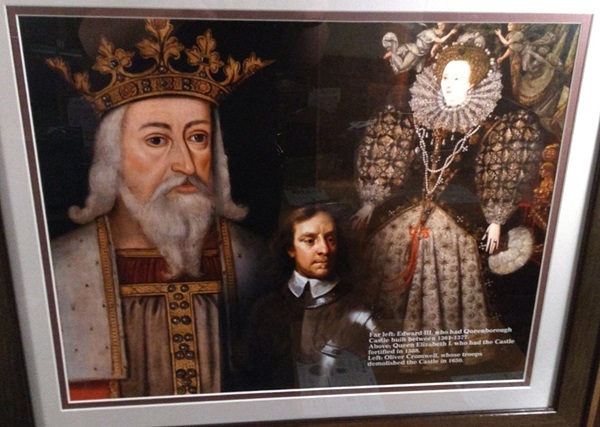
Far left: Edward III, who had Queenborough Castle built between 1361-77
Above: Queen Elizabeth I, who had the castle fortified in 1388
Left: Oliver Cromwell, whose troops demolished the castle in 1650.
Prints of historical figures associated with Sheerness.
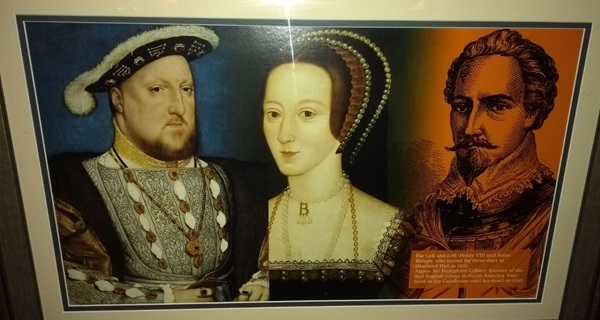
Far left and left: Henry VIII and Anne Boleyn, who stayed for three days at Shurland Hall in 1532
Above: Sir Humphrey Gilbert, founder of the first English colony in North America, who lived in the Gatehouse until his death in 1583.
A photograph, illustration and text about Shurland Hall.
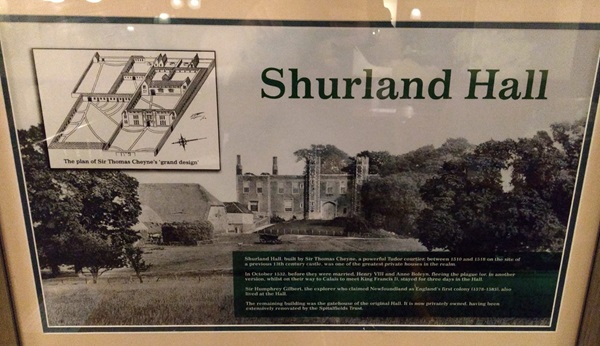
The text reads: Shurland Hall, built by Sir Thomas Cheyne, a powerful Tudor courtier, between 1510 and 1518 on the site of a previous 13th century castle, was one of the greatest private houses in the realm.
In October 1532, before they were married, Henry VIII and Anne Boleyn, fleeing the plague for, or in another version, whilst on their way to Calais to meet King Francis II, stayed for three days in the Hall.
Sir Humphrey Gilbert, the explorer who claimed Newfoundland as England’s first colony (1578-83), also lived at the Hall.
The remaining building was the gatehouse of the original hall. It is now privately owned, having been extensively renovated by the Spitalfields Trust.
Prints, illustrations and text about Sheerness and the Dutch Raid.
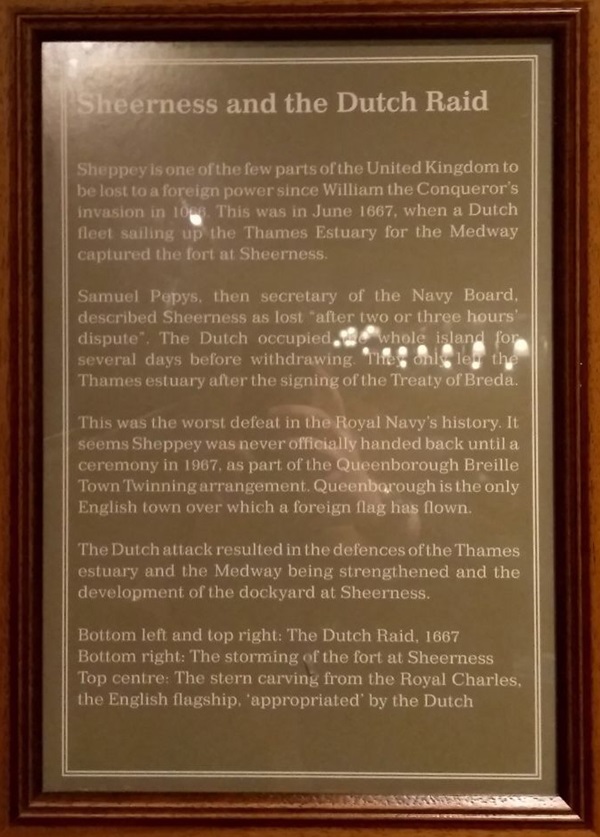
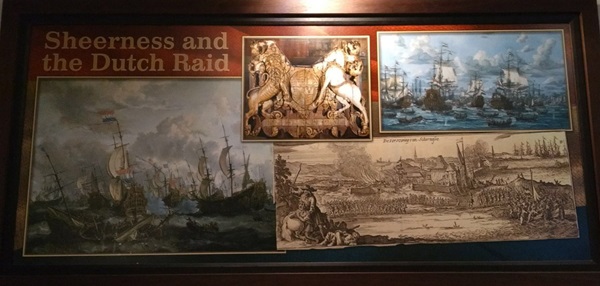
The text reads: Sheppey is one of the few parts of the United Kingdom to be lost to a foreign power since William the Conqueror’s invasion in 1066. This was in June 1667, when a Dutch fleet sailing up the Thames Estuary for the Medway captured the fort at Sheerness.
Samuel Pepys, then secretary of the Navy Board, described Sheerness as lost “after two or three hour’s dispute”. The Dutch occupied the whole island for several days before withdrawing. They only left the Thames estuary after the signing of the Treaty of Breda.
This was the worst defeat in the Royal Navy’s history. It seems Sheppey was never officially handed back until a ceremony in 1967, as part of the Queenborough Breille Town Twinning arrangement. Queenborough is the only English town over which a foreign flag has flown.
The Dutch attack resulted in the defences of the Thames estuary and the Medway being strengthened and the development of the dockyard at Sheerness.
Bottom left and top right: The Dutch Raid, 1667
Bottom right: The storming of the fort at Sheerness
Top centre: The stern carving from the Royal Charles, the English flagship appropriated by the Dutch.
J D Wetherspoon would like to thank the following people and organisations for their generous assistance in compiling the display of local history in The Belle and Lion:
• Blue Town Heritage Centre, 69 High Street, Blue Town
• Minister Gatehouse Museum, Union Road, Minster-On-Sea
• Sheppey Heritage Trust
• Martin Hawkins, private collection
External photograph of the building – main entrance.
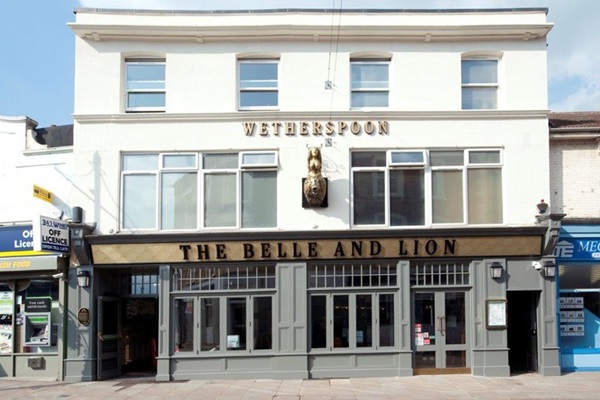
If you have information on the history of this pub, then we’d like you to share it with us. Please e-mail all information to: pubhistories@jdwetherspoon.co.uk